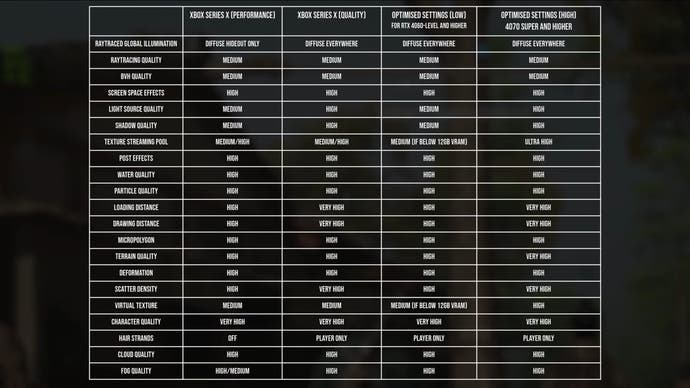We’ve already discussed the improvements to the Assassin’s Creed Anvil Engine and the transformative impact of real-time global illumination – but how does this technology scale to lower-end hardware and how well does the PC version run more generally? More to the point, can that brilliant RTGI be enjoyed on a mainstream PC in a world where you need a PS5 Pro to run the effect at 60fps?
First up, let’s talk about the PC version in a more general sense, kicking with a look at the user experience and options. Starting the kick sees a brief shader compilation burn occur, lasting about 30 seconds on a Ryzen 5 3600, with no signs of further compilation during gameplay. This is a good showing – maybe not up there with, say, Kingdom Come Deliverance 2, but impressive nonetheless. You can get an idea of how Ubisoft handles this by checking out our recent interview with the developer, but suffice it to say, it shouldn’t be a problem, so on the CPU side, even a relatively ancient CPU like the Ryzen 5 3600 should hold its own in delivering 60fps for the majority of content.
On this now very limited chip, I did notice that entering towns or transitioning to new map zones can cause some frame-time spikes – and those spikes are still there, but much diminished on a more capable chip like the Ryzen 7 9800X3D. It would be nice if they were not there at all of course, but they are not exactly peppering the experience and they are rather distant from one another usually. If they bother you, I recommend a frame-rate cap or even standard v-sync, which tends to limit their visual and measurable severity. Even with that aside, frame-times tend to be pretty OK in this new AC game – not bad bearing in mind the series’ legacy of high CPU utilisation on PC.
Another well handled aspect are the menu options: these are well presented with useful scaling, plentiful options and meaningful preview imagery. One of my favourite options in the menu conceptually is how dynamic resolution is handled, with it being able to be combined with DLSS and other upscalers, where the quality settings of the upscaler affect the minimum and maximum resolutions, where 25 percent on the scale for example represents the ‘performance’ mode of the scaler. The DRS itself is a touch slow to react in comparison to other games, but it is still useful and highly recommended in concert with optimised settings.
So, there’s a lot of good user experience stuff here in Shadows, but not everything is perfect. Some settings tweaks still require a full game reload, while toggling other options can have strange performance impacts. I recommend only toggling options in real-time to check out visual differences and to restart afterwards to ensure consistent, expected performance.
The bigger user experience I have concerns cutscene presentation, as they are limited to one aspect ratio (bordered on 16:9 screens) and one frame-rate – 30fps. This leads to a tremendous discontinuity between narrative and gameplay content. On top of that, AC Shadows has an issue with its frame-rate limiter: it doesn’t support properly frame-paced 30fps with v-sync active and actually seems to cap at 31fps. Not even a VRR panel will escape the ensuing stutter. And yes, for game content, a 60fps cap within a higher refresh rate container doesn’t work either – 61fps on a 120Hz screen doesn’t look great either. Bearing in mind that the consoles manage a proper 30fps cutscene presentation, Ubisoft really does need to fix this.
The last user experience issue I have concerns unexpected performance. The game is stable, but GPU scaling can be temperamental based on time of day. Basically, as time of day changes, frame-rate diminishes by anything up to 25 percent in my tests, before rising again. The logical conclusion here is that different lighting conditions result in different GPU loads, right? Except I discovered that adjusting and confirming settings (eg shadows) while this happens restores full performance. Whatever the issue is, it is confusing and needs looking at.
Let’s talk about optimised settings, where I had two specific priorities: firstly, unlike the Series X and PS5 performance modes, I did not want to lose RTGI. And secondly, I did not want to lose the strand-based hair system, which is a real technical highlight. If you watch the video on this page, you’ll see how we tackle changes to all of the key settings to achieve our best balance of quality and performance, with specific set-ups targeting lower range GPUs and then everything else. Allowances also need to be made based on how much VRAM your GPU has: the virtual texturing quality setting is best set to medium on 8GB graphics cards, but can go higher with GPUs that have 12GB or higher.

Tested on an RTX 4070 Ti Super, the low optimised settings at 1440p output with DLSS performance mode can see a 40 percent performance uplift vs the maxed out experience, with just a small drop to a 38 percent boost in outdoor areas. On an RTX 4060 using DLSS quality mode at 1080p using the optimised low settings which of course include RTGI and hair strands, frame-rate varies from 50fps to 70fps. Either way, I recommend dynamic resolution to help out variability and of course, implementing a frame-rate cap from reliable sources such as driver-level limits or Special K.
Summarising, Assassin’s Creed Shadows has a lot of scalability, meaning that even a lower-end system with a Ryzen 5 3600 paired with an RTX 4060 can achieve good performance overall. Still, there are some issues. It is not exactly a stutter-free experience with some traversal stutters peppering the experience, and as I say this, a patch dropped recently that added in stutters each and every time in some scenarios, like opening the doors to the assassin dens or other actions with contextual button prompts, which is definitely not nice to see.
There are some other issues beyond frame-time spikes that need developer examination: is RTGI actually working above the medium setting? We’re not sure. Should time of day really tank performance in the way it does now? This seems unlikely. Hopefully further patches will improve the game but even as things stand, this is a reasonably impressive PC port of an excellent game.

